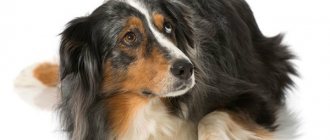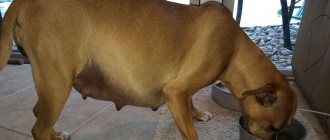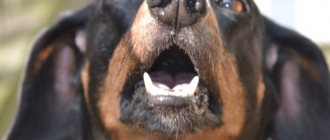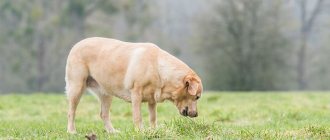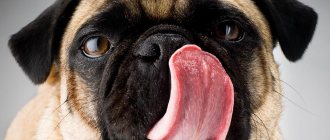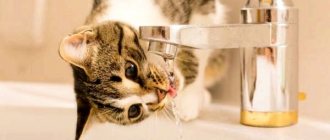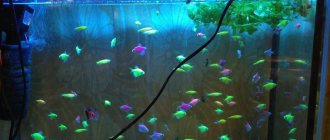If you care about your health, then you probably monitor your daily diet and the amount of water in it. As you drink your next glass of life-giving moisture, remind yourself that your dog needs it just as much. Its quality and quantity play an important role in maintaining the health and replenishment of the pet’s vitality. Many breeders simply try to keep the animal's water bowl stocked without thinking about how much water the dog needs to drink per day to keep his body healthy. Let's find out how correct this is.
Fluid intake in dogs
Veterinary experts have developed several formulas that can be used to calculate the approximate amount of required fluid in a dog’s diet. We are not talking about exact calculations, because how much water a pet should normally drink per day depends on many factors, and the norm may change throughout the dog’s life. When we are talking about a healthy individual without any special conditions (no pregnancy, not after surgery, etc.), 3 calculation methods are used:
- For cubs, 100 ml per 1 kg of body weight, for adult dogs - 50 ml per kilogram of body weight.
- A formula is also used to calculate the minimum-maximum range, which is also based on weight indicators. The lower limit of the norm is the dog’s weight multiplied by 20, the upper limit is the weight multiplied by 70. The unit of measurement for the result obtained is milliliters. For example, for a dog weighing 10 kg:
10 kg x 20 = 200 (ml)
10 kg x 70 = 700 (ml)
So, a ten-kilogram dog needs to drink from 200 to 700 ml of water per day. If the dog is hot or spends the day in a state of increased stress, it needs to drink more; in a calm state, the lower limit of the norm is acceptable, your four-legged friend will feel great.
- Another calculation option is power-related. For dogs that eat dry food, the presence of liquid is extremely important, since this food contains a lot of salt. Animals should consume 2 times more water than solid food eaten. If you prepare your dog's food yourself, the water requirement is 1:1. As much as your pet eats, you should drink as much. It is convenient if the food and water bowls are the same in volume, this helps to see the ratio of what was drunk and what was eaten.
How much water is enough?
The norm may differ depending on the climate, diet, breed, age, and activity of the pet. Follow the rule: your dog should drink at least 50 milliliters of water per 1 kilogram of weight. It is easy to calculate that an animal weighing 30 kilograms needs one and a half liters per day - the volume of an ordinary plastic bottle of mineral water.
Be sure to watch the amount you drink. Pay attention to what level you fill the bowl and how much it has dropped after a day. It is worth noting that boiled water relieves thirst less than raw water.
Puppies, lactating bitches, small breed dogs, and animals on a diet of dry food need a lot of fluids. But if your pet drinks more than 100 milliliters per 1 kilogram of weight during the day, you should be wary and seek advice from a specialist.
Factors influencing water consumption
There are circumstances that can affect the amount of water consumption for an animal and which cannot be ignored:
- First of all, the need for water is influenced by factors in the pet’s environment. In hot weather or if the dog is kept in a stuffy room with dry air, he will tend to drink more.
- The need for water also increases in pregnant dogs, because during this period the amount of blood in the female’s body increases, and a resource is also needed to renew the amniotic fluid.
- After the birth of the puppies, the female will be at risk of dehydration; it is necessary to take care of a sufficient amount of accessible and high-quality water. In addition, the new mother will need fluid to produce milk.
- The postoperative period should be accompanied by constant monitoring of the hydration of the mucous membranes. If the dog is not able to drink on its own, it is necessary to moisten the mouth with drinking water (the eyes and nose are treated with saline solution).
- Thirst increases naturally when your dog takes diuretics.
We must not forget about the importance of having a watering hole for the animal on the road. Whether the dog is at home or traveling with you, his physiological needs remain with him. And to replenish them, add a bottle or two of water to your luggage for your pet. A portable drinking bowl will be a convenient gadget for a dog in such conditions.
How long can a dog live without water?
It is known that a dog can survive without water for 2-3 days . Environmental factors largely influence, in particular air temperature and humidity, the level of activity of the animal itself and the type of food consumed. Naturally, a dog that is without water, but feeds on the flesh of animals, will live longer than an animal that does not have the opportunity to eat. Lack or absence of water leads to dehydration. With a lack of moisture, the functionality of internal organs, in particular the liver and kidneys, is impaired. As a result, dehydration leads to the death of the animal. Dehydration can be determined by several signs. To do this, you need to pull up the folds of skin above the upper part of the shoulder blade and lower it; if there is no lack of moisture, then the skin will quickly return to its original position , otherwise the skin slowly returns to its place and even remains elongated for some time. You need to check your gums; smooth and moist gums indicate a normal level of moisture, while dry, sticky and pale gums indicate a lack of moisture in the body . When dehydrated, animals have dry and sunken eyes, a dry nose and tongue, and thick saliva.
Basic requirements for water quality
It is natural for any owner to quench the thirst of a pet from a bowl that is regularly replenished with water. The pet itself may have a radically different view of things. And it happens that the dog suddenly begins to ignore his bowl and goes to the watering hole... to the toilet. For a person this may be a shock, for a dog it may be the order of things in his world. A scavenger by nature, the dog may not be disdainful of rummaging in the trash; he does not have a feeling of disgust when contacting the toilet. The reasons why a dog prefers water in the toilet to his bowl are as follows: the water in the toilet is regularly updated, it is cooler. Perhaps the dog does not like the smell of the watery contents of the bowl.
It is still worth weaning the animal from this habit. There is a high probability that traces of the chemicals you use to clean the toilet may remain on the earthenware walls, which can lead to poisoning. If the animal is in close contact with the owners and their children, this is a matter of hygiene for the whole family. Properly watering your dog, like any other living creature, is necessary for health benefits and non-harm reasons. Provide the animal with the opportunity to quench its thirst in places that are safer from all points of view: ensure clean, fresh and cool water in a bowl or other place intended for the dog to drink. These are the “three pillars” of the main requirements for a source of quenching your pet’s thirst.
Why do dogs drink toilet water even if their bowl is full of water?
Dogs are scavengers by nature. It really is in their genes and has been going on for thousands of years. Some of us like to think of them as hunters and survivalists, but in reality this is far from the case.
Finding food in trash cans is a favorite activity of dogs, and every owner of this pet knows this. Do you notice your dog rummaging through the trash, sniffing out kitchen scraps, not moving from the grill grate, and eating any scraps that fall on the floor? Yes, dogs just love leftovers. And yes, it is quite natural that they quench their thirst from a source other than a bowl of water.
First , understand that a dog sees the world differently than a human. A dog’s value system and its understanding of good and bad are radically different from human principles. And even if dogs somehow realized what the toilet is for, it would not affect their worldview in any way. For them, drinking from the toilet is not at all disgusting, but rather natural.
Secondly , the water in the toilet is always cool and clean, unless, of course, the toilet itself is dirty. Cold, fresh water is preferable to water at room temperature. In addition, the water we pour for our pets can sit in the bowl for several hours, and pieces of food can also accumulate there. Add to this the fact that water in a metal or plastic bowl can taste like the material it's made from, and you can see why your dog has a particular affinity for toilet water.
Raw water
Clean, cool water is what you need to cope with thirst. Ordinary tap water will do if you are confident in its quality. If it contains excess chlorine, it must be allowed to settle. When you pour water from the vessel in which it has settled, be careful: what has settled must be left at the bottom; the water from the upper layer must get into the dog bowl. Try to avoid mixing.
If the water is too hard and contains iron and solid particles, use a filter to clean it.
Another cause of dehydration in dogs is diarrhea or diarrhea.
Diarrhea in dogs can cause many health problems and even provoke the development of infections and viruses. Usually in such cases, the veterinarian diagnoses parvovirus, which causes severe diarrhea and vomiting. The dog loses a lot of water, which in turn can cause the dog to become dehydrated.
Monitor your dog's health. To prevent diarrhea in dogs:
- Vaccinate your dog regularly
- Do not allow your dog to dig through garbage or drink water from the toilet,
— Prevention of worms and fleas.
If your dog is dehydrated, you may want to seek further advice from your veterinarian.
PS I liked the article. Share with your friends.
Bottled water
Bottled water is by default considered the purest drinking option for both humans and animals. On the road, this is an ideal option, but using it constantly at home is quite expensive. But if the quality of the tap water in your home tap is completely poor, and for some reason you don’t have access to a filter, it seems you have no other choice.
What types of water are strictly prohibited?
What really should not be allowed is quenching thirst in stagnant bodies of water (due to the critically high probability of containing parasite larvae and pathogenic bacteria in them), and drinking so-called technical water (which is not originally intended for drinking and cooking due to its content in no solid particles).
While on the road, it can be quite difficult to provide water for your pet. For such cases, it is worth buying a travel drinking bowl, which is also a convenient source of quenching thirst for dogs. This is a bottle with a bowl lid designed for drinking. Buying a travel water bottle will make your life much easier when traveling, and you can purchase it at any pet store. Due to the fact that these products are made from different materials, and they have a simpler or more complex configuration, prices for drinking bowls vary from an affordable couple of hundred to more expensive ones, over a thousand rubles.
What kind of water should you not give to your dog?
By analogy with humans, you should not give your dog water that is contaminated with harmful substances or has impurities. You cannot give your dog water, even if it has been purified. The degree of mineralization of water is acceptable for dogs if it is no more than 5 thousand solid particles per 1 million particles of water. It is unlikely that you will be able to independently measure these indicators, so it is better not to risk it at all and exclude such water from the dog’s diet.
Do not allow your pet to drink from puddles and stagnant bodies of water - this is a breeding ground for bacteria and many harmful substances and sediments. Dogs tend to indulge in the joy of drinking water from the toilet. For obvious reasons, you should not allow your dog near the toilet.
The dog drinks little water or refuses it altogether
The reason that a dog is reticent about drinking is not necessarily due to illness.
- Perhaps the need for water is met by eating. This only applies if you are feeding your dog natural food or wet food.
- The need for water also decreases in older dogs.
- A dog may refuse to drink because it does not like the smell of the bowl or the temperature of the water in it. Try changing the bowl to a ceramic one, which is more hygienic and does not absorb odors. Change the water in it frequently to keep it cool and clean. Water that is too cold can also discourage your pet from drinking it.
Refusal to drink is accompanied by the following pathologies: injury, gastrointestinal disorder, poisoning, toothache, and also if the animal has swallowed a foreign object. This is a good enough reason to immediately contact a veterinarian.
Why doesn't the dog drink water?
If a dog drinks little water, this fact is not necessarily associated with health problems. It is possible that the animal is getting enough moisture from its food, especially if it is natural feeding or feeding wet commercial food. Wet food contains about 70-80% moisture. By the way, when switching a pet from dry food to natural feeding, they consume less water.
- Older dogs drink less, their appetite may decrease, and at the same time the feeling of thirst decreases. Older animals forget to quench their thirst or cannot find a bowl of water due to cognitive impairment (memory impairment), or the water is too far away and the animal does not want to put in much effort to get there.
- Poor health, accompanied by a number of signs, may indicate a disease. In the presence of injury, digestive upset, toothache, poisoning, pancreatitis, a foreign body entering the gastrointestinal tract, as well as being in a stressful, depressive state, dogs do not drink water or drink very little. If your pet's refusal to drink water is not related to health problems, then you should pay attention to the quality of the water.
- The drinking water in the bowl should be fresh and cool and should be changed at least 2 times a day. The dog may not like the taste and smell of water, which can be transmitted from a plastic bowl. It is better to use small ceramic bowls so that the water does not stagnate and remains cool. When changing water, the bowl should be washed and thoroughly rinsed off detergents, if used.
- Perhaps the dog does not drink water because it is warm or very cold, or has an unpleasant taste due to the content of harmful metals, chlorine, and salts in the case of tap water. It is better to filter it or buy bottled. If the steps taken do not help and the dog does not drink water, then you should think about purchasing a drinking fountain. It has been noticed that pets are more willing to drink water from a drinking fountain than from a regular bowl, because the liquid in the fountain is constantly circulating, cooled and cleaned.
Additional sources of moisture can be fruits and vegetables, which are beneficial for animals. Vegetables and fruits should be given raw. You can force a dog to drink water by improving its taste - adding berries or pieces of fruit to the water that the pet loves, but are harmless to its body . To cool the water, you can add ice cubes to it. Another way to get your dog to drink water is to place a bowl of water near the dog's sleeping area or in areas that the dog visits most often. You can give your pet a treat or otherwise praise him every time he drinks water.
If your dog drinks a lot of water
Excessive thirst may have explainable reasons, which we discussed above. If your dog has a calm lifestyle, there is no special stress, the house is not hot and the air is sufficiently humidified, the pet does not eat dry food, he does not take medications that could cause thirst, and if you do not have a pregnant or lactating female, but The dog began to drink a lot of water, you should be wary.
There are a number of diseases that cause dehydration and polydipsia (increased thirst). Among them:
- imbalance of calcium in the blood;
- diabetes mellitus and other hormonal diseases;
- tumor formations;
- inflammatory processes in internal organs;
- pathologies of the hypothalamus;
- urethral obstruction and others.
These diseases cannot be diagnosed independently; a serious examination is required, which begins with a blood test of the animal. Do not hesitate to contact a veterinary clinic.
Which water bowl is better?
The main property of a good water bottle for a dog is ease of use. Don't buy bowls made of cheap plastic, it can release harmful substances into its contents. Prefer dishes made of ceramics, food-grade plastic or stainless steel. The size should match the size of the pet: between a large and a small bowl, choose the large one. For large breed dogs there are special stands with adjustable height of the dishes above the floor. To prevent the bowl from sliding on the floor, choose options with a rubberized insert on the bottom.
Animals willingly drink running water. Let your pet enjoy the experience with an automatic water fountain for dogs.
How to give your dog water on the road
Traveling with a faithful four-legged friend will bring much more pleasure if it is comfortable and safe for both the owners and the pet. Avoid situations where the dog, in order to quench its thirst, is forced to drink water in puddles and the first standing water it comes across. It’s as easy as shelling pears to catch the health-hazardous protozoa from such bodies of water! When going on a trip, make sure you have clean drinking water. If you travel by car, and the size of your luggage does not matter as much as when hiking, you can take your animal’s homemade bowl with you and water it during stops.
But if you don’t want to carry or carry unnecessary things with you, but at the same time care about convenience, purchase a travel drinking bowl for travel. It will help you out more than once on the road and will not take up much space in your luggage. The convenient bowl-lid of this bottle-shaped device allows the animal to drink to its heart's content, doing it carefully, keeping the dog's mustache and muzzle dry.
To keep your four-legged friend healthy, observe his behavior and eating habits from time to time, and then you will not miss dangerous “bells” indicating the approach of illness. Health to you and your pet!
Article Rating
conclusions
The importance of water for the proper functioning of the dog’s body and their condition lies in the fact that water dissolves and transports nutrients in the body. In addition, water plays an important role in helping dogs adjust to ambient temperatures and maintain optimal body temperature to avoid overheating. Therefore, the presence of a certain amount of water in a dog’s body is one of the main conditions for its normal life.
It should also be borne in mind that dogs endure a lack of water much more severely than a lack of all nutrients combined. If, depending on its fatness, a dog can live for several weeks without food, then without water it can die within a few days. And if, during forced starvation, a dog is able to tolerate a loss of 40% of body weight, then if it is deprived of water, it dies with a loss of 22% of body weight.
The water requirement of adult dogs under normal conditions is about 40 ml per 1 kg of body weight per day . In puppies this figure is 2–3 times higher. Also, dogs' need for water depends on their size - the smaller their body weight, the higher the need.
On average, an adult service dog's water requirement is about 2.5 liters per day. 40% of this amount comes from drinking water, 45% is found in soups and feed. The remaining 15% is water, which is formed in the dog’s body as a result of digestive processes.
Dogs need to be given clean, odorless water. It should not be too cold and not too hard. If you give your dog tap water, it is better not to boil it, since boiled water often negatively affects the condition of dogs' tooth enamel. The dog needs to be provided with free access to water, which should be in its usual place.
